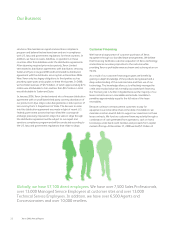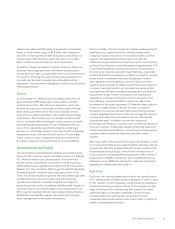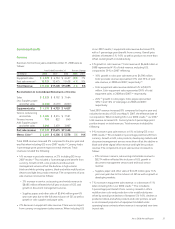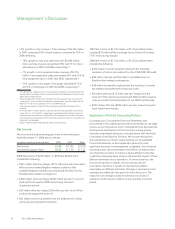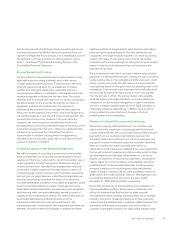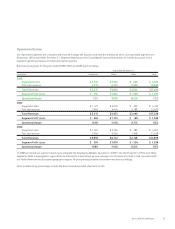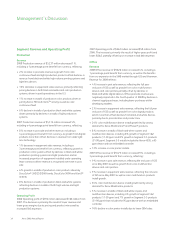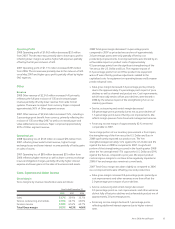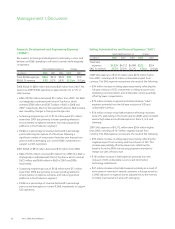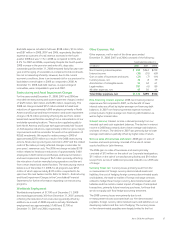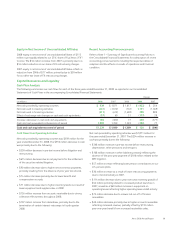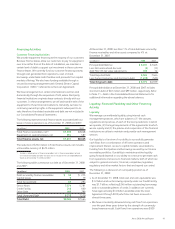Xerox 2008 Annual Report Download - page 34
Download and view the complete annual report
Please find page 34 of the 2008 Xerox annual report below. You can navigate through the pages in the report by either clicking on the pages listed below, or by using the keyword search tool below to find specific information within the annual report.
Management’s Discussion
and can be reasonably estimated. We assess our potential liability
by analyzing our litigation and regulatory matters using available
information. We develop our views on estimated losses in
consultation with outside counsel handling our defense in these
matters, which involves an analysis of potential results, assuming a
combination of litigation and settlement strategies. Should
developments in any of these matters cause a change in our
determination as to an unfavorable outcome and result in the
need to recognize a material accrual, or should any of these
matters result in a final adverse judgment or be settled for
significant amounts, they could have a material adverse effect on
our results of operations, cash flows and financial position in the
period or periods in which such change in determination, judgment
or settlement occurs.
Business Combinations and Goodwill
The application of the purchase method of accounting for business
combinations requires the use of significant estimates and
assumptions in the determination of the fair value of assets
acquired and liabilities assumed in order to properly allocate
purchase price consideration between assets that are depreciated
and amortized from goodwill. Our estimates of the fair values of
assets and liabilities acquired are based upon assumptions believed
to be reasonable, and when appropriate, include assistance from
independent third-party appraisal firms.
As a result of our acquisition of GIS, as well as other prior year
acquisitions, we have a significant amount of goodwill. Goodwill is
tested for impairment annually or more frequently if an event or
circumstance indicates that an impairment loss may have been
incurred. Application of the goodwill impairment test requires
judgment, including the identification of reporting units,
assignment of assets and liabilities to reporting units, assignment
of goodwill to reporting units and determination of the fair value
of each reporting unit. We estimate the fair value of each reporting
unit using a discounted cash flow methodology. This requires us to
use significant judgment including estimation of future cash flows,
which is dependent on internal forecasts, estimation of the long-
term rate of growth for our business, the useful life over which cash
flows will occur, determination of our weighted average cost of
capital for purposes of establishing a discount rate and relevant
market data.
Our annual impairment test of goodwill is performed in the fourth
quarter. The estimated fair values of the Company’s reporting
units were based on discounted cash flow models derived from
internal earnings forecasts and assumptions. The assumptions and
estimates used in those valuations incorporated the expected
impact of the challenging economic environment that has
persisted over the past year. In performing our 2008 impairment
test, the following were the overall composite long-term
assumptions regarding revenue and expense growth, which were
the basis for estimating future cash flows used in the discounted
cash flow model: 1) revenue growth 3%; 2) gross margin 39-40%;
3) RD&E 4-5%; 4) SAG 24-25%; and 5) return on sales 8-9%. We
believe these estimated assumptions are appropriate for our
circumstances, in-line with historical results and consistent with our
forecasted long-term business model. These assumptions also have
considered the current economic environment.
Based on those valuations, we determined that the fair values of
our reporting units exceeded their carrying values and no goodwill
impairment charge was required during the fourth quarter. In light
of the continued difficult economic conditions and the fact that
the Company’s stock has been generally trading below net book
value per share over the past quarter, we reassessed our
assumptions as of December 31, 2008. We do not believe the
recent general downturn in the U.S. equity markets is
representative of any fundamental change in our business. Based
on current results and expectations, we determined that the fair
values of our reporting units continue to exceed their carrying
values and determined that no goodwill impairment charge was
required as of December 31, 2008.
Refer to Note 1 – Summary of Significant Accounting Policies –
“Goodwill and Intangible Assets” for further information regarding
our goodwill impairment testing, as well as Note 8 – Goodwill and
Intangible Assets, Net in the Consolidated Financial Statements for
further information regarding goodwill by operating segment.
32 Xerox 2008 Annual Report


